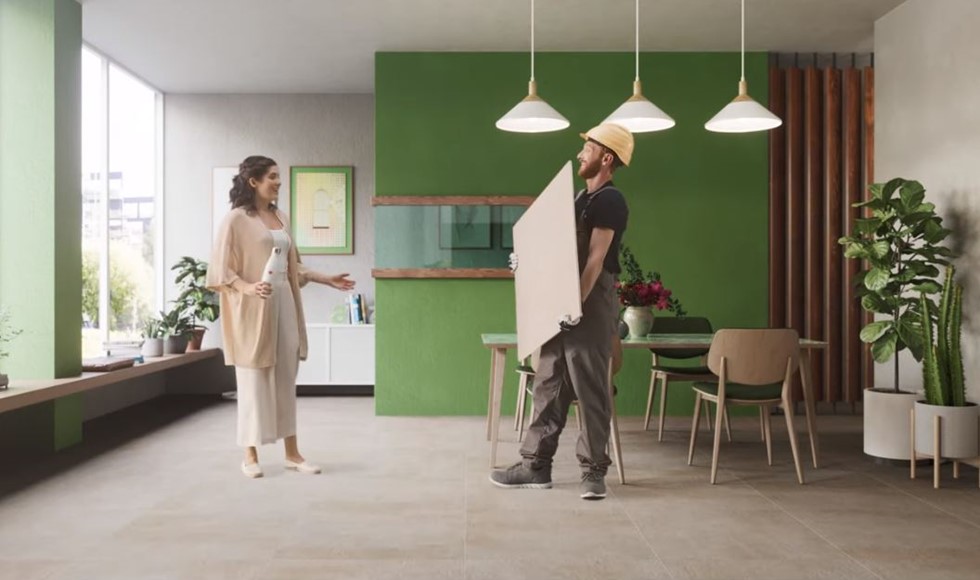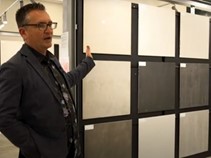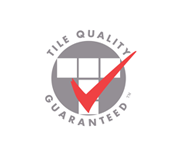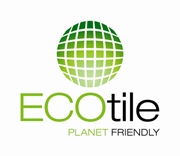
Environmental sustainability in building design is becoming more and more of a priority as we better understand how our actions affect the world we live in. Research has revealed that we can do our part by choosing construction materials that can be sourced, manufactured, used, maintained, and disposed of with minimal impact on the environment.
With a host of environmental benefits that minimise global warming potential and other threats, as well as contribute to green building programmes, tile is an ideal sustainable material choice.
Ceramic & Porcelain Tile’s Environmental Advantages
What makes tile an environmentally friendly material choice? Tile’s eco-friendly benefits range from manufacturing through the end of its life-cycle, including the following advantages:
Naturally occurring and indigenous raw materials: Tile is made of naturally occurring clays and minerals, the majority of which are commonly sourced within 500 miles of manufacturing facilities. Not only does this mean products are made from ingredients you can feel comfortable with using in construction and living with day after day, it means significantly decreased emissions and energy, which would otherwise result from long-distance shipping.
Life-cycle benefits: Tile is incredibly durable, allowing it to be used for generations without replacement. Since tile’s potential service life is at least as long as the building in which it is installed, environmental impacts from manufacturing, installation, and disposal are considered only once, unlike some other flooring options that need to be replaced frequently, each time adding to their environmental impact.
Energy efficiency: The inherent thermal mass of ceramic tile minimises peak heating and cooling, in turn moderating temperature swings, reducing the use of HVAC systems, and saving energy.
Re-cycling and reclamation: Tile manufacturers offer wide varieties of products with pre- and post-consumer recycled content. Additionally, high levels of responsibly recovered waste — including dust, powder, unfired scrap, and water — are commonly reincorporated into tile manufacturing. This “closed loop” approach to manufacturing minimises waste and maximises resources.
Salvageability: Tile finishes are among the few surfaces that can be salvaged in a major renovation, and tiles can also be repurposed for other interior or exterior decorative projects.
Clean disposal and/or beneficial reuse: Tile is solid and 100% inert. This means it is nonwater soluble, won’t leach caustic liquids, and can’t decompose, making it the perfect material for clean fill per U.S. Environmental Protection Agency (EPA) criteria. Additionally, when ground up, ceramic tile is the perfect candidate for beneficial reuse, such as in paving and asphalt applications.
Additonal Information from the North American Tile Council:
How Tile Benefits the Environment
While tile might be chosen based on the above beneficial characteristics, the recently certified North American industry-wide Environmental Product Declaration (EPD for ceramic tile) from the Tile Council of North America (TCNA) provides transparency of six environmental impact categories.
Over 85% of North American-made ceramic tile is covered by the EPD. The EPD discloses ceramic tile’s environmental impact throughout all stages of the product’s life cycle of 75 years, including production, construction, use, maintenance, refurbishment and replacement, and end of life, also known as cradle to grave.
Simply stated, this industry-wide EPD is a report of the environmental footprint of the North American ceramic tile industry. The environmental impacts reported by the EPD are significantly lower than those reported by EPDs for flooring composed of plastic based materials, such as luxury vinyl tiles and planks. In particular, a direct comparison to publicly available UL-Certified industry-wide EPDs for vinyl tile and rigid core board reveals the following:
Vinyl tile’s 75-year global warming potential and fossil fuel resource depletion are two and three times higher, respectively, than ceramic tile’s.
Rigid core board’s 75-year global warming potential and fossil fuel resource depletion are three and five times higher, respectively, than ceramic tile’s.
The most important environmental considerations affecting the well-being of the planet are addressed in the EPD:
Global warming potential: A key factor to consider when determining embodied carbon, global warming potential (GWP) measures carbon-equivalent gas emissions and is related to climate change. When compared to publicly available EPDs for other types of floor coverings, the ceramic tile EPD revealed that tile contributes less to global warming than any other flooring option. Because ceramic tile has the lowest 75-year GWP value, it also has the lowest cradle-to-grave embodied carbon. With respect to embodied carbon, it is important to consider a product’s cradle-to-grave GWP because this represents every stage of a product’s life cycle.
Ozone depletion potential: When chlorofluorocarbons and hydrofluorocarbons reach the stratosphere and react with the sun, they begin to break down the ozone layer, allowing increased levels of UV-B radiation to reach Earth’s surface. This radiation in turn harms the health of humans and animals, ecosystems, and more. When compared to publicly available EPDs for other types of floor coverings, the ceramic tile EPD revealed that ceramic tile has one of the lowest ozone depletion potentials of all flooring types.
Smog potential: Photochemical oxidant creation potential, or smog potential, occurs when hydrocarbons, nitrogen oxides, and volatile organic compounds react with sunlight to produce the air pollution we know as smog. Smog causes bronchial-related diseases in both humans and animals, stunts plant growth because of decreased UV radiation, and discolors building facades and the like. When compared to publicly available EPDs for other types of floor coverings, the ceramic tile EPD revealed that ceramic tile has the lowest smog potential of any flooring type.
Acidification potential: Acidification potential refers to the lowered pH levels of soil and bodies of water, polluting groundwater and harming organisms, ecosystems, and man-made materials alike. When compared to publicly available EPDs for other types of floor coverings, the ceramic tile EPD revealed that ceramic tile has the lowest acidification potential of all flooring options.
Eutrophication potential: When nutrient levels in a body of water become excessive, they cause increased algae and plant growth that blocks the sunlight needed for oxygen production and thus harms marine life. This process is referred to as eutrophication, and from a comparison of the ceramic tile EPD to publicly available EPDs for other types of floor coverings, ceramic tile is less likely to contribute to it than any other flooring type.
Fossil fuel resource depletion: Various nonrenewable energy resources (such as petroleum, coal, and natural gas) are used throughout the manufacture, installation, maintenance, and disposal of a product. When compared to publicly available EPDs for other types of floor coverings, the ceramic tile EPD revealed that ceramic tile contributes less to the depletion of these fossil fuel resources than any other flooring choice.
Using Tile’s Environmental Transparency to Meet Green Building Requirements
In addition to directing people toward the most sustainable construction materials, EPDs can help meet transparency requirements and achieve green building points. Participating in green building programs is ideal for a number of reasons, from creating greater energy- and cost-efficient buildings to catching tax breaks.
Specifying ceramic tile covered by the ceramic tile EPD allows you to meet the requirements of many leading green building programs, including the following:
- LEED v4.1
- Green Globes ANSI/GBI 01-2019
- NAHB National Green Building Standard
- International Green Construction Code (IgCC) powered by ASHRAE Standard 189.1
- Collaborative for High-Performance Schools (CHPS)
- CALGreen
- GSA P-100 Facilities Standards
Mortar and grout are also covered by EPDs, and most green building standards provide additional credit for each product used, so you can likely achieve additional points by using mortar and grout in your project in addition to tile. The EPD “package” (tile, mortar, and grout) provides triple ingredient transparency and recognition in green building programs.

Tile: The Proven Sustainable Choice
The environmental benefits resulting from tile’s inherent raw materials, durability, long life, and low maintenance are clear. Compared to other flooring products that need to be replaced more frequently, ceramic tile’s long life means it is both cost-effective and a smart choice for reducing embodied carbon, as well as other negative environmental impacts, including resource use, and demolition waste. Not only is ceramic tile incredibly durable, environmentally friendly, and easy to care for, it is also available in an unlimited variety of styles to meet any aesthetic. No other building material can compare.
Ref: WHYTILE.COM

If you would like to discuss your project further, we can assist with specification and product selection.
Contact one of our Commercial Representatives today.












